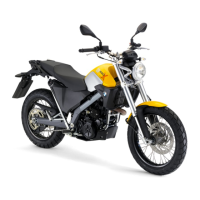Brake pads
New brake pads must "bed
down" and therefore do not
achieve their optimum friction
levels during the first 300 miles
(500 km). This initial reduction
in braking efficiency can be
compensated for by exerting
greater pressure on the levers.
New brake pads can ex-
tend stopping distance by a
significant margin.
Brake early.
Tires
New tires have a smooth sur-
face. This must be roughened by
riding in a restrained manner at
various heel angles until the tires
are run in. This running in proce-
dure is essential if the tires are to
achieve maximum grip.
New tires have not
achieved their full adhesion
yet. There is a danger of
accidents when driving at
extreme angles.
Avoid extreme angles.
Brakes
How is the shortest
braking distance
achieved?
The dynamic load distribution
between the front and rear wheel
changes during braking. The
heavier you brake, the more
the front wheel is loaded. The
greater the wheel load, the more
braking force can be transferred.
To achieve the shortest possible
braking distance, the front brake
must be applied quickly and with
increasing force. This optimal-
ly utilizes the dynamic load in-
crease on the front wheel. At the
same time, the clutch should al-
so be actuated. With the "forced
braking" often practiced in which
the brake pressure is generat-
ed as quickly as possible and
with great force, the dynamic
load distribution cannot follow
the increased deceleration and
the braking force cannot be com-
pletely transferred to the road
surface. To prevent the front
wheel from locking, the ABS sys-
tem must intervene and reduce
the brake pressure; the braking
distance increases.
Descending mountain
passes
There is a danger of the
brakes fading if you use on-
ly the rear brakes when descend-
ing mountain passes. Under
extreme conditions, the brakes
could overheat and suffer severe
damage.
Use both front and rear brakes,
and make use of the engine's
braking effect as well.
5
47
z
Riding

